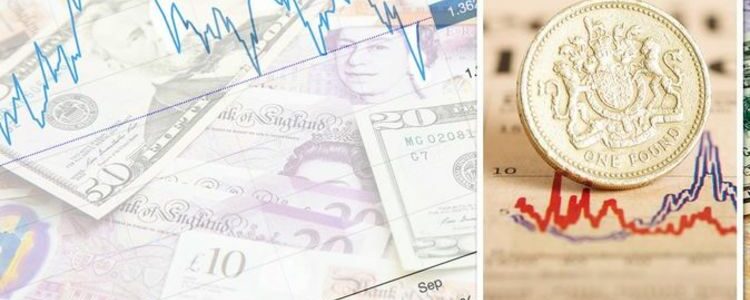
Pound rebound: Sterling recovery extends against dollar – but can it last? Expert insight
Pound Sterling seen advancing on the US Dollar
We use your sign-up to provide content in ways you’ve consented to and to improve our understanding of you. This may include adverts from us and 3rd parties based on our understanding. You can unsubscribe at any time. More info
The British pound has suffered amid the deepening energy and fuel crisis in the UK. However, this was overshadowed by a notable recovery in October. Higher inflation is pushing the Bank of England towards raising interest rates sooner than previously anticipated but this was not treated as a buying signal for the currency. Express.co.uk speaks to economic experts about the rebound of the pound and whether this performance will continue and what it means compared to the dollar and euro.
The British pound is tipped to remain supported over time according to experts.
Adverse headlines about shortages have impacted the pound, but investors believe it will rebound.
The pound was easily the worst performing of the world’s major currencies by the mid-week session last week, suggesting there were some UK-specific factors bothering investors and this was not simply a typical ‘high beta’ event for the currency.
A combination of the ongoing energy crisis and the potential for materially higher inflation contributed to this negative impact on the economy.


Britain’s economic recovery since the coronavirus pandemic is being hampered by supply chain disruptions a former Bank of England chief economist claimed.
The UK’s inflation rate hit 3.2 percent in August – the highest rate in a decade.
The nation’s economy grew rapidly earlier this year as the country opened in the wake of lockdown easing.
But in July, economic growth slowed according to official data with the sluggish growth continuing in the face of severe supply chain issues.

However, the pound staged a notable recovery into October 1 which is probably helped the completion of month-end and quarter-end repositioning on global markets.
George Vessey currency strategist at Western Union Business Solutions said the pound is moving slowly in line with global events and risks.
Mr Vessey told Express.co.uk: “The British pound moves closely in line with global risk sentiment, which has been rattled amidst growing downside risks such as inflation fears, tightening policy expectations, China’s Evergrande crisis and the weakening credit cycle.
“Nevertheless, GBP/USD rebounded two cents over Friday and Monday and continues to jostle with the $1.36 level today.”
DON’T MISS
Drivers complain of E10 fuel issues, say petrol is ‘burning quicker’ [INSIGHT]
State pension age should be scrapped, Boris Johnson told [EXPLAINER]
Boris Johnson to overrule Sturgeon in Brexit trade plot [ANALYSIS]

Mr Vessey added trade and vaccination optimism led to a surge in the value of the pound earlier this year.
However, “post-Brexit challenges have aggravated recent supply chain issues and a shortage of workers” which has impacted the value.
The currency strategist said: “Ongoing supply chain chaos, tensions with the EU over Northern Ireland and the lack of US-UK trade deal will remain material headwinds to the pound this quarter, but the hawkish Bank of England and rising UK gilt yields should entice investors and offer GBP support.
“GBP/USD may find the $1.36 difficult to hold above, but GBP/EUR is already showing signs of scaling back towards €1.18.”

A senior market analyst at Trade Nation David Morrison said the beginning of October began with the Sterling making gains against the US dollar and Euro.
Over the past few days, the pound has risen 1.5 percent against the dollar and 1.3 percent against the single currency.
Mr Morrison told Express.co.uk: “From the height of the pandemic in March 2020 to the following February, the sterling rose 24 percent against the US dollar and 10 percent against the euro.”
Prior to this the dollar and euro had sharply risen as the pandemic took its impact with the dollar considered the ultimate safe-haven currency.
Mr Morrison added: “Traders took advantage of the sell-off in the British pound and by February this year had pushed it back up to levels last seen in the first half of 2018.
“Then between June and September, the pound lost nearly six percent against the dollar.”
The analyst attributes this decline to a reversal in fortune for the dollar rather than the performance of the pound.
The dollar rallied in June prompting investors to become increasingly convinced the US Federal Reserve will start to wind down its bond purchase program before the year-end.
This would lead to a removal of monetary stimulus from the financial system and is seen as a precursor to raising interest rates.
Mr Morrison said last month the Bank of England revised its growth forecasts down and raised its inflation outlook which could have an impact on sterling.
The analyst told Express.co.uk: “We may be seeing a rally in sterling now, but this could simply be a mild correction as the US central bank begins to tighten monetary policy in the next few months.”
Jeremy Thomson-Cook, chief economist at international business payments specialist Equals Money said the sterling had suffered a bumpy ride last week amid the deepening fuel crisis and driver shortage.
Mr Thomson-Cook said the end of the furlough scheme and Universal Credit uplift also contributed to the market struggles.
He added the Bank of England Governor’s statement about the rise in interest rates was expected to bring forward expectations of the first UK rate rise to February next year.
Source: Read Full Article